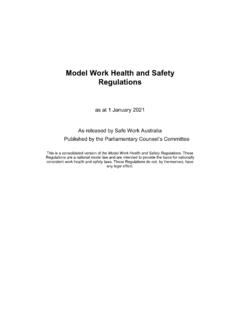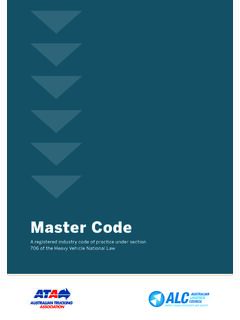Transcription of Mode Code of Practice How to manage work health and …
1 HOW TO manage work health AND safety risks Code of PracticeDECEMBER 2011 Safe work Australia is an Australian Government statutory agency established in 2009. Safe work Australia consists of representatives of the Commonwealth, state and territory governments, the Australian Council of Trade Unions, the Australian Chamber of Commerce and Industry and the Australian Industry work Australia works with the Commonwealth, state and territory governments to improve work health and safety and workers compensation arrangements. Safe work Australia is a national policy body, not a regulator of work health and safety .
2 The Commonwealth, states and territories have responsibility for regulating and enforcing work health and safety laws in their 978-0-642-33301-8 [PDF] ISBN 978-0-642-33302-5 [RTF]Creative CommonsExcept for the logos of Safe work Australia, SafeWork SA, WorkSafe Tasmania, WorkSafe WA, Workplace health and safety QLD, NT WorkSafe, WorkCover NSW, Comcare and WorkSafe ACT, this copyright work is licensed under a Creative Commons Attribution-Noncommercial Australia licence. To view a copy of this licence, essence, you are free to copy, communicate and adapt the work for non commercial purposes, as long as you attribute the work to Safe work Australia and abide by the other licence information Safe work Australia Phone: 1300 551 832 Email: Website: OF Practice | HOW TO manage work health AND safety risks TABLE OF CONTENTSFOREWORD 21.
3 INTRODUCTION Who has responsibility for managing work health and safety risks ? The meaning of key terms What is involved in managing risks ? When should a risk management approach be used? 62. STEP 1 HOW TO IDENTIFY HAZARDS How to find hazards 83. STEP 2 HOW TO ASSESS risks When should a risk assessment be carried out? How to do a risk assessment 104. STEP 3 HOW TO CONTROL risks The hierarchy of risk control How to develop and implement control options How to ensure that controls remain effective 175. STEP 4 HOW TO REVIEW CONTROLS 186. KEEPING RECORDS 19 APPENDIX A ASSESSING HOW THINGS GO WRONG 20 APPENDIX B RISK REGISTER 21 APPENDIX C CASE STUDIES 22 CODE OF Practice | HOW TO manage work health AND safety risks 2 This Code of Practice on how to manage work health and safety risks is an approved code of Practice under section 274 of the work health and safety Act (the WHS Act).
4 An approved code of Practice is a practical guide to achieving the standards of health , safety and welfare required under the WHS Act and the work health and safety Regulations (the WHS Regulations).A code of Practice applies to anyone who has a duty of care in the circumstances described in the code. In most cases, following an approved code of Practice would achieve compliance with the health and safety duties in the WHS Act, in relation to the subject matter of the code. Like regulations, codes of Practice deal with particular issues and do not cover all hazards or risks that may arise. The health and safety duties require duty holders to consider all risks associated with work , not only those for which regulations and codes of Practice exist.
5 Codes of Practice are admissible in court proceedings under the WHS Act and Regulations. Courts may regard a code of Practice as evidence of what is known about a hazard, risk or control and may rely on the code in determining what is reasonably practicable in the circumstances to which the code with the WHS Act and Regulations may be achieved by following another method, such as a technical or an industry standard, if it provides an equivalent or higher standard of work health and safety than the code. An inspector may refer to an approved code of Practice when issuing an improvement or prohibition notice.
6 This Code of Practice has been developed by Safe work Australia as a model code of Practice under the Council of Australian Governments Inter-Governmental Agreement for Regulatory and Operational Reform in Occupational health and safety for adoption by the Commonwealth, state and territory draft of this Code of Practice was released for public consultation on 7 December 2010 and was endorsed by the Workplace Relations Ministers Council on 10 August 2011. SCOPE AND APPLICATIONThis Code provides practical guidance for persons who have duties under the WHS Act and Regulations to manage risks to health and safety .
7 The duty is placed on persons conducting a business or undertaking, including employers, self-employed, principal contractors, persons with management or control of a workplace, designers, manufacturers, importers and suppliers of plant, substances or structures that are used for Code applies to all types of work and all workplaces covered by the WHS Act. Other approved codes of Practice should be referenced for guidance on managing the risk of specific TO USE THIS CODE OF PRACTICEIn providing guidance, the word should is used in this Code to indicate a recommended course of action, while may is used to indicate an optional course of Code also includes various references to sections of the WHS Act and to regulations which set out the legal requirements.
8 These references are not exhaustive. The words must , requires or mandatory indicate that a legal requirement exists and must be complied with. FOREWORDCODE OF Practice | HOW TO manage work health AND safety RISKS3 Who has responsibility for managing work health and safety risks ?The WHS Act and Regulations require persons who have a duty to ensure health and safety to manage risks by eliminating health and safety risks so far as is reasonably practicable, and if it is not reasonably practicable to do so, to minimise those risks so far as is reasonably conducting a business or undertaking will have health and safety duties to manage risks if they.
9 Engage workers to undertake work for them, or if they direct or influence work carried out by workers may put other people at risk from the conduct of their business or undertaking manage or control the workplace or fixtures, fittings or plant at the workplace design, manufacture, import or supply plant, substances or structures for use at a workplace install, construct or commission plant or structures at a what is reasonably practicable to protect people from harm requires taking into account and weighing up all relevant matters, including: the likelihood of the hazard or risk concerned occurring the degree of harm that might result from the hazard or risk knowledge about the hazard or risk, and ways of eliminating or minimising the risk the availability and suitability of ways to eliminate or minimise the risk, and after assessing the extent of the risk and the available ways of eliminating or minimising the risk, the cost associated with available ways of eliminating or minimising the risk.
10 Including whether the cost is grossly disproportionate to the process of managing risk described in this Code will help you decide what is reasonably practicable in particular situations so that you can meet your duty of care under the WHS (for example company directors) must exercise due diligence to ensure that the business or undertaking complies with the WHS Act and Regulations. This includes taking reasonable steps to: gain an understanding of the hazards and risks associated with the operations of the business or undertaking ensure that the business or undertaking has and uses appropriate resources and processes to eliminate or minimise risks to health and person can have more than one duty and more than one person can have the same duty at the same time.












